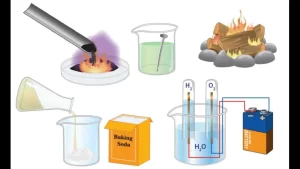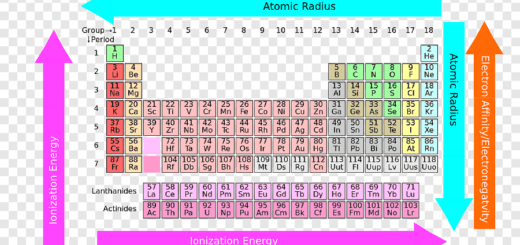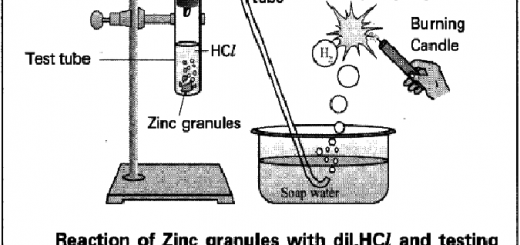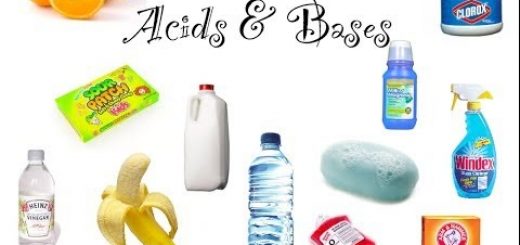Speed of chemical reactions, Types of catalytic reactions and Catalytic converter
Catalyst is used in some chemical reactions to increase the rate of chemical reactions. Reactions between ionic compounds are fast whereas, reactions between covalent compounds are slow because the reactions of ionic compounds take place between ions, while the reactions of covalent compounds take place between molecules.
Speed (rate) of chemical reactions
What are the factors affecting the speed of chemical reactions?
You know from the previous lesson that chemical reaction is a process that includes changing of chemical substances (reactants) to another one (products). Chemical reactions differ in the speed of their occurrence, where there are:
- Very fast reactions: They occur in a very short time. Ex.: Fireworks.
- Relatively slow reactions: They occur in a short time. Ex.: The reaction of the oil with caustic soda (NaOH) to form soap.
- Very slow reactions: They need several months to occur. Ex.: Rusting of iron.
- Too slow reactions: They need millions of years to occur. Ex.: Reaction of petroleum oil formation inside the Earth.
Concept of the speed of the chemical reaction
The following graph represents the speed of a chemical reaction:
- The concentration of the reactants at the beginning of the reaction (100%).
- The concentration of the reactants at the end of the reaction (Zero).
- The concentration of the products at the beginning of the reaction (Zero).
- The concentration of the products at the end of the reaction (100%).
The measuring unit of concentration of the substance is mole/liter
- At the beginning of the reaction: The concentration of the reactants (X) is the largest (100 %), The concentration of the products (Y) is the smallest (zero %).
- By passing time: The concentration of the reactants decreases, The concentration of the products increases.
- At the end of the reaction: The concentration of the reactants becomes the smallest (zero %). The concentration of the products becomes the largest (100 %).
From the previous explanation, we can define the speed of chemical reaction as follows:
The speed of chemical reaction is the change in the concentration of the reactants and the resultants at a unit time.
Application
The speed of decomposition (dissociation) of nitrogen pentoxide (N2O2), Nitrogen pentoxide decomposes (breaks up) into nitrogen dioxide and oxygen gas:
2N2O5 → 4NO2 + O2 ↑
- At the beginning of the reaction: The concentration of the reactants (N2O5) is the largest (100 %), The concentration of the products (NO2, O2) is the smallest (zero %).
- By passing time: The concentration of the reactants decreases, The concentration of the products increases.
- At the end of the reaction: The concentration of the reactants becomes the smallest (zero %). The concentration of the products becomes the largest (100 %).
The end time of the reaction is evidenced by the constancy of concentration of both the reactants and the products by passing time.
Measuring the speed of the chemical reaction
The speed of a chemical reaction can be measured practically by the rate of disappearance of one of the reactants or the appearance of one of the resultants.
Application
The rate of reaction of sodium hydroxide solution with copper sulphate solution.
2NaOH + CuSO4→ Na2SO4 + Cu (OH)2 ↓
The speed in the previous reaction is measured practically by: The disappearance rate of the blue colour of copper sulphate solution (reactant). Or the formation rate of the blue colour precipitate of copper hydroxide (resultant).
Factors affecting the speed of chemical reaction
- The nature of the reactants.
- The concentration of the reactants.
- The temperature of the reaction.
- Catalysts.
The nature of the reactants
The effect of the nature of the reactants depends on two factors which are:
- The kind of bonding in reactants.
- The surface area of reactants exposed to reaction.
The kind of bonding in reactants
The kind of bonding (ionic or covalent) in the molecules of reactants affects the speed of chemical reaction as in the following:
lonic compounds
The reactions of ionic compounds are fast because they take place between ions, where they break up (dissociate) completely into ions on dissolving in water.
Covalent compounds
Most of the reactions of covalent compounds are slow because they take place between molecules, where they are difficult to ionize on dissolving in water.
The reaction between sodium chloride solution and silver nitrate solution is from fast reactions because it takes place between ions that resulted from the dissociation of them in water.
Na+ Cl− + Ag+ NO3−→ Na+ NO3− + Ag+ Cl−
The surface area of the reactants exposed to reaction
The surface area of the reactants exposed to the reaction affects the speed of the chemical reaction as in the following:
The reaction of substance (A) with substance (B)
When the reactant substance (B) is as a big-sized piece, The molecules of substance (A) react with the molecules of the outer surface only of the substance (B) and don’t react with the molecules inside the bulk. So, The reaction is slow because the surface area exposed to the reaction is small.
When the reactant substance (B) decomposes to become as powder or filings or turning, The molecules of substance (A) react with the molecules of the outer surface of the substance (B) and also with the molecules inside the bulk. so, The reaction is fast because the surface area exposed to the reaction is large.
From the previous explanation, we conclude that: As the surface area of the reactants exposed to the reaction increases, the speed of chemical reaction increases.
Effect of surface area on the speed of the chemical reaction
The speed (rate) of this reaction is measured by the time required to complete the reaction, which is evidenced by the constancy of the concentration of the formed gas in the syringe.
Procedures:
- Put the iron filings in flask (1) and the iron piece in the flask (2).
- Add two equal amounts of dil. HCI acid in both flasks.
- Compare between the speed of the reaction in the two cases by noticing the out movement of the two syringes.
Fe + 2HCl → Fe Cl2 + H2 ↑
Observation: The rate of reaction of hydrochloric acid with iron filings is faster than that in case of a piece of iron.
Explanation: The surface area of iron filings exposed to reaction with the acid is more than the surface area of the iron piece, so the reaction in case of iron filings ends in a short time than that in case of the iron piece.
Conclusion: The speed of chemical reaction increases by increasing the surface area of the reactants exposed to reaction.
The speed of the chemical reaction increases by increasing the surface area of the reactants exposed to the reaction due to increasing the number of molecules of reactants exposed to the reaction.
Using nickel filings in hydrating oil instead of pieces of nickel because the speed of chemical reaction increases by increasing the surface area exposed to the reaction.
A certain mass of iron filings reacts with acids faster than the reaction of a block of iron has the same with acids because the surface area in case of iron filings is larger than in case of iron block and the speed of chemical reactions increases by increasing the surface area.
Concentration of the reactants
You may have noticed that: The probability of collisions between persons in a crowded street is bigger than that in a quiet street. Similarly, When the concentration (no. of molecules) of the reactants increases, the number of probable collisions between molecules increases, thus the speed of chemical reaction increases.
Effect of reactants concentration on the speed of the chemical reaction
Procedures:
- Put a piece of magnesium ribbon in two flasks.
- Add a small amount of dil. HCI acid in flask (1) and the same amount of conc. HCI acid in flask (2) by using a pipette.
- Compare between the amount of the evolved bubbles after a certain period of time by noticing the amount of the gas formed in both syringes.
The speed (rate) of this reaction is measured by the amount of the evolved gas through a certain period of time.
Mg + 2HCl → MgCl2 + H2 ↑
Observations:
- The amount of the evolved bubbles in case of using conc. hydrochloric acid is more than that in case of dil. hydrochloric acid.
- The rate of the reaction of magnesium ribbon with conc. hydrochloric acid is faster than that in case of dil. hydrochloric acid.
Explanation: The number of molecules of acid in concentrated solution is more than that in its diluted solution, which leads to increasing the number of probable collisions between reactant molecules, so the speed of chemical reaction increases.
Conclusion: The speed of chemical reaction increases by increasing the concentration of the reactants.
The speed of chemical reaction increases by increasing the concentration of the reactants because by increasing the number of reactant molecules, the number of probable collisions between them increases
Combustion of the steel scourers used for cleaning aluminium pots in a jar filled with pure oxygen is faster than its combustion in atmospheric air due to increasing the speed of chemical reaction by increasing the concentration of oxygen gas.
Temperature of the reaction
On increasing the temperature of the reactants, the speed of the reactants molecules increases. so the number of probable collisions between them increases, so the speed of the chemical reaction increases.
Effect of temperature on the speed of the chemical reaction
Procedures:
- Put one of the effervescent tablets in hot water and the other in cold water.
- Compare between them in terms of the speed of occurrence of effervescence.
Observation: The effervescence that happens in the case of hot water is faster than that in the case of cold water.
Explanation: The speed of the reactant molecules in the case of hot water is greater than that its speed in case of cold water, which leads to increasing the number of probable collisions between molecules, so the speed of the chemical reaction increases.
Conclusion: The speed of the chemical reaction increases by increasing the temperature of the reaction.
The speed of chemical reaction increases by raising temperature due to increase in the number of probable collisions between reactant molecules
The fridge is used to preserve food because the low temperature in the fridge slows down the speed of the chemical reactions done by bacteria which cause the rot of food
If you want to cook food faster, you have to increase its temperature because the speed of reactions of cooking food increases by raising the temperature.
Catalysts
To increase or decrease the speed of the chemical reactions, it is necessary to add certain chemical substances to them that don’t affect the nature of the products, these chemical substances are known as catalysts.
A catalyst is a chemical substance that changes the rate of the chemical reaction without changing or being used up. Chemical reactions in which catalysts are used are known as catalytic reactions, which are divided into two types according to the role of the catalyst as in the following diagram:
Types of catalytic reactions
- Positive catalytic reactions: They are chemical reactions in which the catalyst increases their speeds.
- Negative catalytic reactions: They are chemical reactions in which the catalyst decreases their speeds.
Most catalysts speed up the chemical reaction. ie. Positive catalysts.
Common factors (properties) of catalysts
- Catalysts change the speed of reaction but don’t affect either its beginning or stopping.
- Catalysts are used in a few amounts which are often enough to complete the reaction.
- They are bonded to reactants during the reaction but get separated from them rapidly (quickly) after the formation the resultants at the end of the reaction
- They decrease the energy needed for the reaction.
- No chemical changes or decrease in mass occur to the catalyst after ending the reaction.
Effect of the catalyst on the speed of the chemical reaction
Procedures:
- Put hydrogen peroxide in the glass beaker, then add a small amount of manganese dioxide powder to it.
- Compare between the amount of the evolved bubbles before and after adding manganese dioxide.
Observation:
Increasing the amount of the evolved bubbles on adding manganese dioxide powder to hydrogen peroxide
Explanation: Manganese dioxide is a catalyst that increases the speed of decomposition of hydrogen peroxide into water and oxygen gas which evolves as bubbles.
Conclusion: The speed of the chemical reaction increases by adding a catalyst.
2H2O2→ 2H2O + O2 ↑
Enzymes
The human body contains many types of chemical substances which act as catalysts in the laboratory known as Enzymes.
Enzymes are chemical substances produced by the body of a living organism, act as catalysts that increase the speed of biological reactions.
The biological reactions occur in the presence of enzymes are more rapid than that without the enzymes, by thousands or even by millions times. Each enzyme has a specific function, a molecule of one enzyme can do its function million times per one minute. Without enzymes, man can never breathe, move or even digest food
Effect of enzymes on the speed of the chemical reaction
Procedures:
- Put an amount of hydrogen peroxide in a glass beaker, then add the piece of sweet potato to it.
- Compare between the amount of the evolved and after adding a piece of sweet potato.
Observation: Increasing the number of the evolved bubbles by adding a piece of sweet potato to hydrogen peroxide.
Explanation: Oxidase enzyme in sweet potatoes acts as a catalyst that increases the decomposition rate of H₂O₂ into water and oxygen.
Conclusion: The speed of the chemical reaction increases by adding an enzyme.
Adding a few manganese dioxide power to hydrogen peroxide increases the number of evolved gas bubbles because manganese dioxide acts as a catalyst which increases the speed of decomposition of hydrogen peroxide into water and oxygen gas.
Adding a piece of sweet potato increases the decomposition of hydrogen peroxide because the oxidase enzyme in sweet potato acts as a catalyst which increases the decomposition rate of hydrogen peroxide into water and oxygen gas.
Catalytic converter
The catalytic converter is a metallic can that exists in most modern cars to treat the harmful gases emitted from the engine.
Structure
It is composed of ceramic cells (similar to bee cells) covered with a thin layer of a catalytic metal as platinum, or palladium or iridium (expensive metals).
Importance
It helps in the treatment of harmful gases emitted from the car engine.
Idea of operation
- Ceramic cells are similar to bee cells which increase the surface area of the catalytic substance exposed to the current of the emitted gases from the engine so as to economize the use of expensive metals.
- The catalysts increase the speed of reactions of the treatment of the harmful gases emitted from the engine.
Usage of sodium bicarbonate in our life
In the home:
- Put a small amount of sodium bicarbonate in the vacuum cleaner bag to get rid of the smell of dust that appears during cleaning.
- Put a small amount of sodium bicarbonate in the bottom of the waste basket before putting the bag to prevent the bad odours.
- Put a small amount of sodium bicarbonate in the kitchen’s sink and pour on it boiling water to make the draining of the sink becomes faster.
- Soak the legumes in water and add a small amount of sodium bicarbonate to help in decreasing the bloating that accompanies eating of legumes.
In polishing metals:
- Put the silver tools in a bowl covered with aluminium foil, then cover them with boiling water added to it sodium bicarbonate, then dried them after rinsing with water to return to their luster.
- Rub any decorative metal pieces made of copper or chrome with a piece of cloth wet with water and immersed in sodium bicarbonate.
In the garden:
Put sodium bicarbonate (without any additives) in the places where ants come out, and by passing time you notice their disappearance.
You can follow science online on YouTube from this link: Science online
You can download Science online application on Google Play from this link: Science online Apps on Google Play
Oxidation and reduction reactions according to Traditional concept & Electronic concept
Substitution reactions, Chemical activity series, types of simple & double substitution reactions
Chemical reactions, Types of thermal decomposition reactions & Air bags importance
Simple and double substitution reactions, Reaction between an acid & a salt
Chemical activity series, Chemical properties of metals & nonmetals




